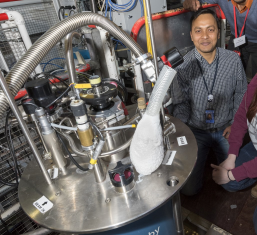Conveners
Supeconductivity I
- Toni Shiroka
Superconductivity and magnetism have been traditionally viewed as antagonistic states of matter. On the other hand over the last decade or so evidence has accumulated for not just coexistence of superconductivity and magnetism, but even intrinsically magnetic superconducting states. I will discuss the complex and sometimes subtle interactions between lack of inversion symmetry, non-symmorphic...
While at Warwick, studying for his PhD, Pabitra was prolific in his work studying superconductivity with Prof. Martin Lees and Prof. Don Paul. His thesis captures perfectly the vast array of experimental work he did during his time at the University of Warwick. He discovered new information on the superconducting properties of FeSe0.5Te0.5, FeTe1-xSx, Lu2Fe3Si5, CaAlSi, ZrB12, and two...
A crucial issue in resolving the mechanism for unconventional superconductivity is the presence or absence of time-reversal symmetry breaking (TRSB), a property that can provide a tight constraint on the symmetry of the superconducting gap. Spontaneous magnetic fields have been measured in a collection of superconductors in µSR experiments, which has been used as evidence for TRSB in these...
The discovery of superconductivity in Nd0.8Sr0.2NiO2 introduced a new family of layered nickelate superconductors that has now been extended to include a range of strontium doping, praseodymium or lanthanum in place of neodymium. A number of studies have indicated that electron correlations are strong in these materials, a feature that often leads to the emergence of magnetism. Here we report...

